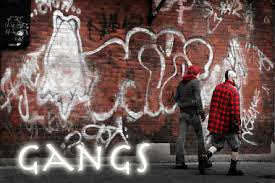After nearly five years of decline from 1996 to 2001, gang problems seem to be on the rise again. This article talks about the statistical findings leading to this conclusions and some statistically sound approaches to gang involvement.
The Decade of Teen Gang Decrease
In 1995, the year that The National Youth Gang Center (NYGC) instituted the annual National Youth Gang Survey (NYGY), the percentage of respondents who report gang problems has been falling in every area type. The four area types are:
- Larger cities (those with a population greater than 50,000)
- Suburban counties
- Smaller cities (those with a population of between 2,500 people and 49,999 people)
- Rural counties
In the first three years of the survey, gang problems were experienced more in more populous areas and less in less populous areas, with Rural counties having less than half the reports of gang problems as experienced in suburban counties, and a bit more than a third of the gang problems reported in Larger cities. The figures were from largest to smallest, 85.6%, 56.0%, 36.5%, and 24.3%.
By the period 1999-2001, those figures had fallen, in some cases, dramatically. Gang problems in rural counties were nearly cut in half (13.5%), while smaller cities saw their gang problems drop by nearly a third (25.9%). Suburban counties had a drop in gang problems of more than a quarter (40.8%). And Larger cities saw a reduction of about a tenth (77.6%).
By 2002, teen gang problems were back on the rise, particularly in the larger areas, and the most recent figures, from 2006, show a continuation of that trend. From 1999-2001 to 2006, Rural counties saw an increase of 1.5% to 14.9%. Smaller cities reported an increase of 6.7% to 32.6%. Suburban counties, though, had an increase of 10.2% for a total of 51%. And Larger cities rose 8.8% to 86.4%.
These gang statistics, however, do not tell the whole story. It is interesting to note that the majority of reports from smaller cities and rural counties, even with the increasing numbers of gangs, had no gang-related homicides, i.e., no homicides in which either a victim or a perpetrator was a gang member. Cities having populations of over 100,000 people, by contrast, tended to have at least one gang-related homicide.
While homicide was not closely associated with teen gang activity in all cases, other crimes carried a more significant link. In 2006, areas that reported an increase of gang-related crime found that it occurred in these areas, and in this order of frequency:
- aggravated assault
- drug sales
- robbery
- larceny/theft
- burglary
- auto theft
The factors that were indicated as most important in increasing the level of gang-related violence were, in order of reporting:
- conflicts between gangs
- factors related to drugs
- migration of gang members within the United States
- the rise of newly formed gangs
- the return to the area of gang members who had been incarcerated
- conflicts within gangs
- migration of gang members from outside of the United States
Statistically Likely Signs of Teen Gang Involvement
Teens who exhibit multiple instances of the following signs may be involved in gang activity. These signs do not guarantee gang involvement, and especially when considered alone, may be representative of something entirely different.
- knowingly associates with gang members
- uses secret codes or signals to communicate with associates
- fixates on particular colors of clothing or a particular logo used on clothing and to decorate other items: this may include posters, tattoos, jewelry, etc.
- has unexplained physical injuries that seem related to fighting
- has more cash or more valuable possessions than one might reasonably expect
- shows particular interest in gang activities, gang-related media and entertainment, etc.
- raises police interest
- withdraws from family, school, and community activities
- breaks his/her curfew and other rules
- is determinedly secretive
- exhibits declines in school performance
